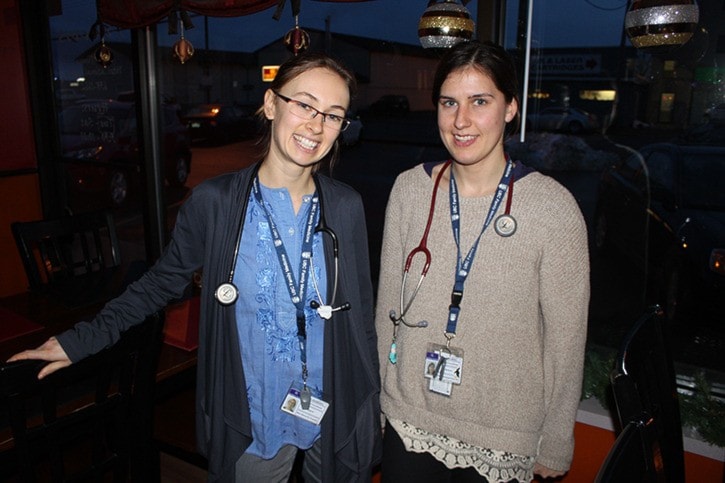Like many who choose Terrace as a place to put down roots, doctors-in-training Adrienne Montgomery and Ariane Mundhenk were drawn here because of the recreational values and strong community.
But if it wasn’t for a government program aiming to ease the way for physicians to live and work in the north, they might have landed elsewhere.
The Northern Medical Program is a physician training program based at the University of Northern British Columbia’s main campus in Prince George and is a satellite to the province’s main medical school at UBC in Vancouver.
After two years of training, students can come to either Terrace or Fort St. John for the third year of their four-year medical degree after which they undertake a two-year residency program to fully qualify as physicians.
Both Montgomery and Mundhenk did their third year at Mills Memorial Hospital here in Terrace and both decided to do their residency program here as well.
“The idea is that if you train in a rural area you will stay rural,” said Mundhenk.
Having partners who also had rural inclinations helped cement their decisions to return to Terrace, a town that might seem big by northern standards but is viewed as a bit of a backwater from the vantage point of Vancouver and other centres where most doctors train.
“Skiing was a huge draw for us,” said Mundhenk.
“My husband works in the ski industry, so it was important for us to be around the mountains. The outdoor stuff was huge.”
The provincial government also has a series of financial incentives to help set up practices and to top up fees, and while Mundhenk describes them as a “bonus,” it’s not the reason they’ve chosen to live here.
“Our partners are happy,” said Montgomery, who adds she was lucky to land a nice rental house.
Mundhenk, on the other hand, has already jumped into the local market by buying a house.
Montgomery describes her experience here as fulfilling thanks to the local medical community.
“I want to trust the people I learn from,” she added.
Their residency supervisor, Terrace physician Greg Linton, said the return speaks to the success of the program.
“This year, with Ariane and Adrienne coming back to do their residency, we have seen some retention of our educational pool,” said Linton.
“They have done some time and are coming back for the next stage of their training.”
Linton himself has been a bit of a rarity among northern physicians in that he’s Canadian-trained.
It was the dependence of northern communities upon doctors trained elsewhere that prompted the call for the training of physicians in the north.
The first 24 students were accepted into the Northern Medical Program in 2004 and in 2008, Mills Memorial Hospital welcomed the first third-year students.
Since then, 18 medical students completed their third-year studies at Mills and six people have finished their residency period.
There has been criticism that the money being spent on northern physician training has resulted in graduates more interested in working down south or elsewhere in Canada and not following through with the intent of the program.
But Dr. Andrea Geller, one of two physicians who directs the Terrace arm of the third-year clerkship program, says it’s far too early to offer up any judgments.
“What people don’t realize is that after they finish their medical program, [graduates] have to go on to their residencies that could be two to five years. It’s really early days yet for people to make those statements,” said Geller.
One of the advantages of doing a residency in a smaller hospital in a smaller community is the broad practical experience that comes from being exposed to all facets of medicine.
Students in the Northern Medical Program divide their weeks between psychiatry, obstetrics, emergency, general surgery and internal medicine.
And sometimes they are allowed to help out on basic surgical procedures.
Terrace is also unique because family doctors, in addition to their private practices, regularly spend time with patients at Mills Memorial Hospital, said Montgomery.
“It’s been a really friendly community,” Mundhenk added.
“We’ve been well supported by the medical community and the community in general.”
Students from the Northern Medical Program can also do their third-year clerkships in Fort St. John in addition to the hospital in Prince George.
